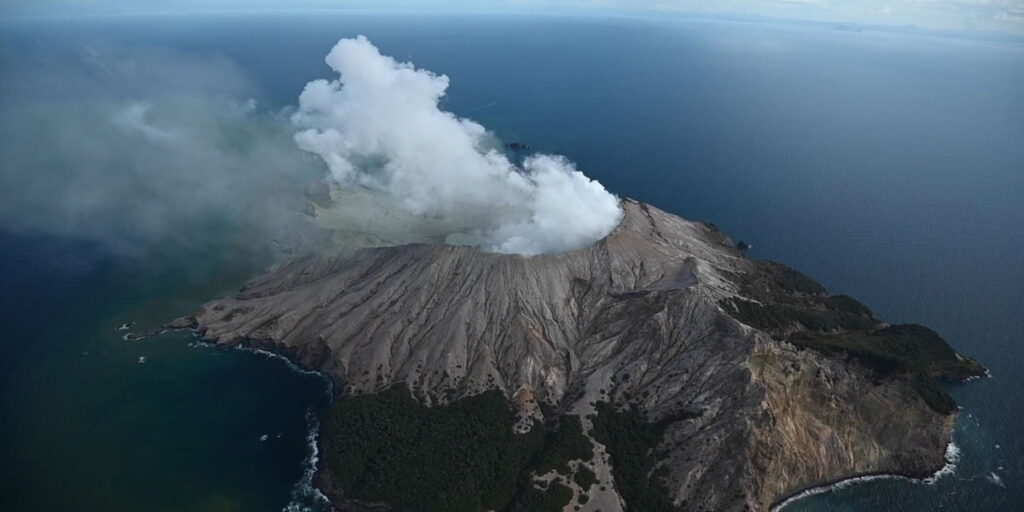🌋 Introduction to Active Volcanoes in New Zealand
In New Zealand, volcanoes play a significant role, adding beauty and potential danger to the country’s environment.
In this article, we’ll explore the world of New Zealand’s active volcanoes, aiming to answer the question: How many volcanoes in New Zealand are active?
1. New Zealand’s Volcanic Landscape
New Zealand sits on the Pacific Ring of Fire, known for earthquakes and volcanic activity. This makes the country home to different types of volcanoes, each with its own features.
The three main types are stratovolcanoes, calderas, and volcanic fields.
2. Active Volcanoes in New Zealand
New Zealand has around 14 active volcanoes. These are spread across both the North and South Islands, forming an important part of the country’s geology.
3. North Island’s Active Volcanoes:
3.1. Ruapehu
- Where It Is: Ruapehu is in Tongariro National Park, an exceptional area in New Zealand known for its unique nature.
- What Makes It Special: One cool thing about Ruapehu is its big hole on the top – that’s called a crater lake. It’s like a natural pool formed by the volcano’s activity mixing with water, making the landscape look amazing.
- What Happened Before: Ruapehu did some exciting stuff in the last 100 years or so. It erupted a few times, throwing out rocks, ash, and gases. This made the area around it change a bit each time.
- Keeping an Eye on It: People are observing Ruapehu. They use special tools to see if it’s going to do anything significant. This helps them tell nearby folks early and make plans to keep everyone safe.
- Staying Safe: Because Ruapehu is close to where people live, there are plans in case it does something unexpected. They practice being safe and might need to leave if it’s unsafe to stay.
- Learning More About It: Scientists continually study Ruapehu to understand it better. They want to know how the hot stuff inside the volcano, water, and other things work together. This helps them be ready for anything it might do.
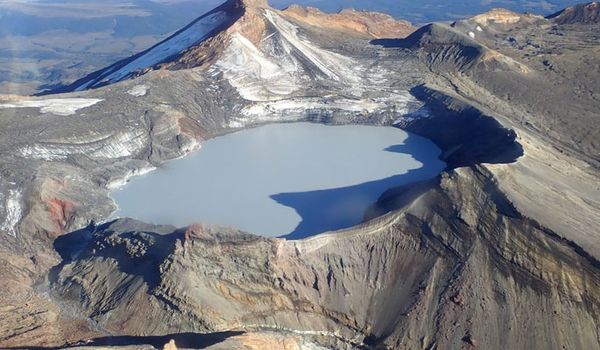
3.2. Tongariro: A Special Place in New Zealand
- Where It Is: Tongariro is a special place in New Zealand, found in a place called Tongariro National Park.
- What Makes It Special: What’s cool about Tongariro is that it has fantastic landscapes. One standout feature is the Emerald Lakes – colourful pools created by the volcano’s activity.
- History of Activity: Tongariro has had some exciting times, too. It erupted less than its neighbour, Ruapehu, but it still showed it could change things around with its volcanic activities.
- Keeping a Watchful Eye: Just like with Ruapehu, scientists are closely monitoring Tongariro. They use special tools to see if anything significant might happen; if it does, they tell people nearby early.
- Staying Safe: Tongariro is close to where people live, too, so there are plans in case something unexpected happens. People practice what to do to keep safe; sometimes, they might need to leave for a little while.
- Learning More About It: Scientists are curious about Tongariro and are always studying it. They want to understand how it works – the hot stuff inside, the water, and everything else. This helps them be ready for anything it might do.
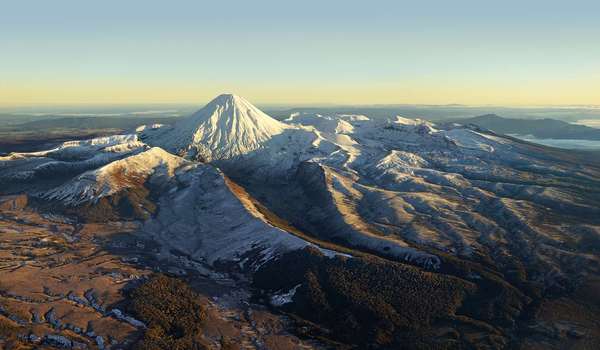
3.3. White Island
- Where It Is: White Island is a special place in New Zealand, and what makes it even more interesting is that it’s a volcanic island located in the Bay of Plenty.
- What Makes It Special: What’s really cool about White Island is its unique landscape. It’s not like a regular island – it’s a volcano in the sea, making it a one-of-a-kind spot.
- History of Activity: White Island has had moments of activity. In 2019, there was a big eruption that caught attention worldwide. This event made people aware of the powerful things nature can do.
- Keeping a Watchful Eye: Because White Island is a bit tricky – being both beautiful and powerful – scientists are watching it closely. They use special tools to check if anything unusual is happening so they can let people know in advance.
- Staying Safe: People can visit White Island by boat or helicopter, but safety is a top priority. There are rules to follow, and if there’s a chance it might do something unexpected, visitors are told to stay away for a while to stay safe.
- Learning More About It: Scientists are really interested in White Island. They study it to understand how volcanoes in the sea work and what makes them do interesting things. This helps everyone be prepared for whatever might happen.
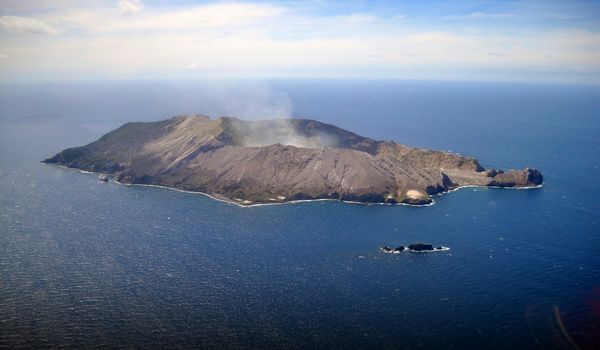
4. South Island’s Active Volcanoes
The South Island of New Zealand is like a big, beautiful puzzle, and part of the puzzle is made up of ancient volcanoes.
These sleeping giants have been around for a very long time, and they have cool stories to tell.
- Mount Somers: Mount Somers is an ancient giant, standing tall at 1,688 meters. It has been around for a whopping 89 million years, making it a living testament to the incredible changes the South Island has seen over time.
- Akaroa Volcano: Akaroa Volcano is a bit mysterious, and we don’t know its exact height, but it’s a part of the South Island’s past from the Miocene era. It adds to the charm of the region with its ancient tales.
- Dunedin Volcano: Dunedin Volcano is like a time traveler, bringing us stories from about 10 million years ago. It stands at 680 meters, adding character to the South Island’s landscapes shaped by its volcanic activities.
- Mount Horrible (near Timaru): Despite its name, Mount Horrible near Timaru has a more calm presence today. It emerged around 2 million years ago, joining the South Island’s lineup of fascinating volcanoes.
- Lyttelton Volcano: Lyttelton Volcano adds a touch of mystery. We don’t have all the details, but it’s likely part of the captivating landscape around Lyttelton. Like the other volcanoes, it plays a role in telling the South Island’s geological tale.

5. Monitoring and Mitigation
New Zealand has a monitoring system called GeoNet, run by GNS Science. It watches for seismic and volcanic activity all over the country.
This helps scientists and authorities give timely warnings and evacuation plans if there’s increased volcanic activity.
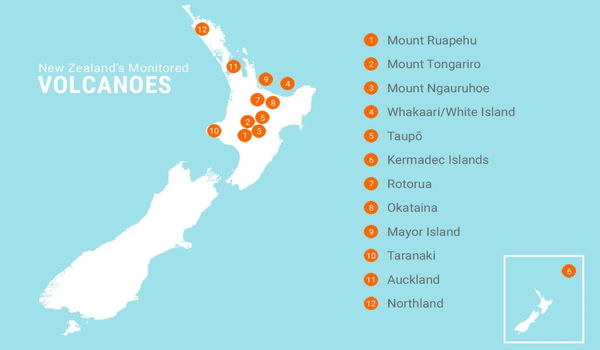
👨💻 Frequently Asked Questions (FAQ) about Active Volcanoes in New Zealand
1. What types of volcanoes are found in New Zealand?
The three main types of volcanoes in New Zealand are stratovolcanoes, calderas, and volcanic fields. Each type has unique characteristics, shaping the country’s varied volcanic terrain.
2. Where is Tongariro National Park located, and why is it significant?
Tongariro National Park is located in the central North Island of New Zealand. It holds UNESCO dual World Heritage status, primarily for its cultural importance to the Maori people and its exceptional volcanic features, including active volcanoes like Ruapehu and Tongariro.
3. What is unique about Ruapehu’s crater lake?
Ruapehu’s crater lake is a distinctive feature formed within the volcanic crater. This lake showcases the dynamic interaction between volcanic activity and water, contributing to the volcano’s captivating landscape.
4. How many times has Ruapehu erupted in the 20th century?
Ruapehu has experienced several eruptions throughout the 20th century, with varying intensities. These eruptions have left their mark on the surrounding landscape and highlight the volcano’s active nature.
5. How is Ruapehu monitored for safety?
Monitoring systems, including tools like seismometers, gas analyzers, and satellite imagery, are in place to monitor Ruapehu’s activity closely. These systems are crucial for detecting any signs of increased volcanic activity and ensuring the safety of nearby communities.
6. Is Tongariro more active than Ruapehu?
While both Ruapehu and Tongariro are active volcanoes, Ruapehu has been more active historically, experiencing notable eruptions. However, both volcanoes are closely monitored, and their activity levels can change over time.
7. What precautions are taken to ensure community safety near active volcanoes?
Community safety near active volcanoes is a top priority. Authorities implement monitoring systems to detect signs of increased volcanic activity early. Evacuation plans and safety drills are practiced, ensuring that communities are well-prepared in case of any volcanic emergencies.
8. Can people visit White Island?
You can go to Whakaari/White Island by boat or helicopter, and there are guided tours when the volcano is not exploding. But, as of January 2023, you can’t walk there on your own. You must join a guided tour to visit Whakaari/White Island to make sure everyone stays safe.
9. Why is ongoing research important for active volcanoes in New Zealand?
Ongoing research helps scientists deepen their understanding of volcanic behavior, enabling better predictions and preparations for potential eruptions. Studying the interactions between magma, water, and other factors contributes to overall knowledge and safety measures for active volcanic sites.
Conclusion
In conclusion, New Zealand’s active volcanoes add to the country’s unique geological landscape. While the number of active volcanoes is small, their potential impact on local communities shows the need for careful monitoring and preparedness.
As we continue to admire these natural wonders, it’s crucial to respect and understand the power underneath, shaping New Zealand’s striking scenery.



